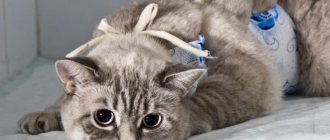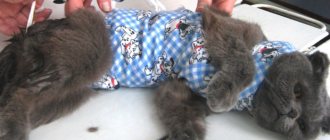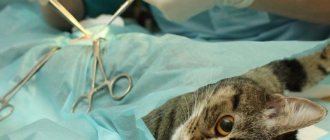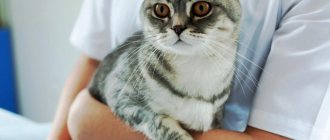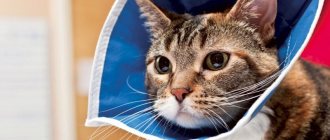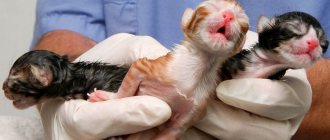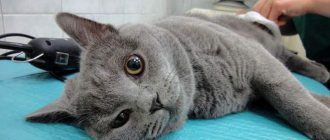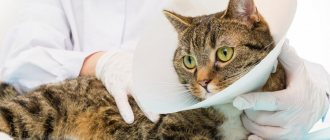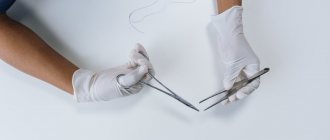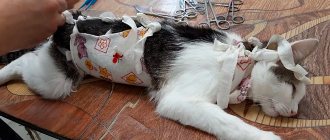Sterilization of a non-breeding cat has a positive effect on its well-being and behavior, helping to reduce the risk of mammary gland cancer, tumors and purulent lesions of the uterus. The procedure for removing the ovaries is not complicated, but it is still an abdominal operation with all its risks. Therefore, animal owners need to approach the care of their pet in the postoperative period with responsibility and attention. You need to know what a suture normally looks like after a cat is sterilized, and how to care for it in order to avoid complications.
How long does it take for a cat to wear off anesthesia after sterilization?
The cat's condition after surgery varies greatly depending on the type of anesthesia. After inhalation (gas) anesthesia, the pet is returned to its owners in full consciousness. Cats recover very quickly after intravenous administration of propofol. It takes them about half an hour to wake up. Therefore, in this section I will talk mainly about intramuscular anesthesia. Usually this is a combination of a muscle relaxant (xylazine/domitor and their analogues) and zoletil. Some doctors use a drug that takes the cat out of medicated sleep. Antisedan removes the domitor effect, and the animal can walk within 30 minutes after the injection.
Cat after sterilization using intramuscular anesthesia
Not all experts yet have an anti-sedan available. Some people simply save money on it (“and so it will wake up”). Others follow the lead of the owners, who find it more convenient to take home a “rag” rather than a meowing cat that is trying to get out of the carrier. All this is unacceptable!
Find out in advance what kind of anesthesia your cat will be given. If after sterilization she is unconscious, it is better to leave her in the hospital under observation for several hours.
Not every clinic has equipment for inhalation anesthesia.
Sterilization operation
Sterilization of the fallopian tubes, according to L.V. Adamyan (2000), PJ Taylor (1995), is one of the most common gynecological procedures. Indications for surgical sterilization:
- the couple's desire for complete fertility prevention;
- intolerance to other methods of contraception;
- medical indications - diseases of the cardiovascular, endocrine, musculoskeletal systems, mental disorders, hereditary diseases in which pregnancy and childbirth are absolutely contraindicated.
Before the operation, it is necessary to obtain the patient’s personal signature agreeing to sterilization. It is necessary to explain to her that restoration of patency of the fallopian tubes after any method of sterilization is not guaranteed.
With a normal menstrual cycle, surgery should be performed in the early proliferative phase. For women using an IUD, it is advisable to perform it 1 cycle after removal of the intrauterine contraceptive device and prophylactic antibacterial treatment. For patients taking oral contraceptives, sterilization can be performed at any time. The combination of artificial termination of pregnancy and sterilization, in our opinion, is inappropriate.
Currently, there are several options for tubal occlusion. Surgical intervention is performed through 2 approaches: a 5-mm trocar - paraumbilical, 5-mm - in the left (right) iliac region or in the midline above the pubic symphysis. If there is an adhesive process or other complicating issues, a third trocar is introduced.
After fixing the fallopian tube with a clamp, it is monopolarly coagulated over a length of 2 cm, 2-3 cm from the angle of the uterus, followed by dissection with endoscissors to the mesosalpinx, which significantly reduces the risk of recanalization. Coagulation can also be performed using a bipolar electrode in 2 or 3 places.
It is possible to excise a section of the fallopian tube 1-2 cm long after preliminary bi- or monopolar coagulation at a distance of 2 cm from the angle of the uterus.
Fimbriectomy involves coagulation and division of the distal portion of the mesosalpins near the infundibulopelvic ligament and the infundibulum of the fallopian tube.
According to the results of studies by Gomel V., Winston L., J. Hulka J., applying Hulka-Clemens clips to the isthmic part of the tube strictly in a perpendicular direction is a method that ensures the highest efficiency of the refertilization operation. In this regard, when deciding whether to perform sterilization, the patient's future need for a procedure to restore patency of the fallopian tubes should be taken into account.
Yun's ring method involves applying silicone rings using a special tool. The fallopian tube is captured by jaws at the junction of the isthmus and the ampulla, pulled into the lumen of the instrument, the ring is put on the loop of the tube and compresses it. Due to ischemic damage to the tube over a long distance, the likelihood of reversibility of this intervention is very low.
LITERATURE on the topic “Laparoscopic operations on the fallopian tubes”
- Puchkov K.V., Politova A.K., Polyakova O.V. Surgical treatment of infertility using minimally invasive technologies // Treatment of infertility: unresolved problems. – Saratov, 2001. – P. 129-130.
- Puchkov K.V., Politova A.K., Polyakova O.V., Tyurina A.A., Pkhitikova B.Kh. Surgical treatment of female infertility using minimally invasive technologies: method. recommendations. - Ryazan: RyazGMU, 2002. - 37 p.
- Puchkov K.V., Politova A.K., Kozlachkova O.P., Polyakova O.V., Pkhitikova B.Kh. Results of surgical treatment of female infertility using minimally invasive technologies // Laparoscopy and hysteroscopy in gynecology and obstetrics / ed. IN AND. Kulakova, L.V. Adamyan. – M.: PANTORI, 2002. – P.273-274.
- Puchkov K.V., Politova A.K., Polyakova O.V., Ruchkina E.N. Correction of female infertility using minimally invasive technologies // Endoscopic surgery. – 2002. – T.8, No. 3. – P.49.
- Puchkov K.V., Politova A.K., Ivanov V.V., Martynova G.V. Clinical effectiveness of organ-preserving operations in the complex treatment of inflammatory diseases of the uterine appendages // New technologies in gynecology / ed. IN AND. Kulakova, L.V. Adamyan. – PANTORI. – M., 2003. – P.187-188.
- Puchkov K.V., Martynova G.V., Politova A.K., Ivanov V.V. Clinical effectiveness of organ-preserving operations in the complex treatment of inflammatory diseases of the uterine appendages // Current issues of health of the population of the center of Russia / ed. M.F. Sautkina, O.E. Konovalova. – Ryazan, 2003. – P. 72-74. – (Collected scientific works / Ryazan State Medical University named after I.P. Pavlov; Issue III).
- Puchkov K.V., Kozlachkova O.P., Politova A.K., Polyakova O.V., Ivanov V.V. Surgical aspects of the treatment of tubo-peritoneal infertility // Current problems of pelvic surgery. - M., 2003., pp. 70–73.
- Puchkov K.V., Martynova G.V., Ivanov V.V., Polyakova O.V. Organ-preserving operations in the complex treatment of inflammatory diseases of the uterine appendages: assessment of clinical effectiveness // X Russian-Japanese Med. symposium, Yakutsk, August 22 – 25, 2003: abstract. report - Yakutsk, 2003. - P. 629.
- Puchkov K.V., Pkhitikova B.Kh., Shavaeva V.A. Immune status of patients with tubal-peritoneal infertility, the effectiveness of its correction using roncoleukin // Current issues in obstetrics, gynecology and perinatology: materials of the 4th interregion. scientific-practical Conf. - Nalchik, 2004.- P.26-28.
- Puchkov K.V., Ivanov V.V.. Technology of dosed ligating electrothermal effects at the stages of laparoscopic operations: Monograph. - M.: ID MEDPRACTIKA - M. - 2005. - 176 p.
- Puchkov K.V., Politova A.K.. Laparoscopic operations in gynecology: Monograph.- M.: MEDPRACTIKA - M.- 2005.- 212 p.
- Puchkov K.V., Polyakova O.V., Martynova G.V. Surgical treatment of tubo-peritoneal infertility using minimally invasive technologies // Current issues of modern surgery. Regional (Southern Federal District) scientific-practical. conf. surgical doctors, Nalchik, May 26-27, 2006 - Nalchik, 2006.- P. 231-232.
- Puchkov K.V., Polyakova O.V., Martynova G.V. Possibility of increasing the effectiveness of surgical treatment of female tuboperitoneal infertility // Current issues of modern surgery. Regional (Southern Federal District) scientific-practical. conf. surgical doctors, Nalchik, May 26-27, 2006 - Nalchik, 2006.- pp. 232-234.
- Puchkov K.V., Pkhitikova B.Kh., Shavaeva V.A. Immune status of patients with tubo-peritoneal infertility, the effectiveness of its correction using roncoleukin // Current issues of modern surgery. Regional (Southern Federal District) scientific-practical. conf. surgical doctors, Nalchik, May 26-27, 2006 - Nalchik, 2006. - P. 239-241.
- Puchkov K.V., Ivanov V.V., Polyakova O.V. Ways to increase the effectiveness of surgical treatment of female tuboperitoneal infertility // Journal. obstetrics and women's diseases. - 2006. - T. 55 (special issue) - P.34-35.
- Puchkov K.V., Pkhitikova B.Kh., Ivanov V.V. Results of complex treatment of tubo-peritoneal infertility using minimally invasive surgical technologies and immunocorrective therapy of recombinant human interleukin-2 // Endoscopic surgery. – 2007. – T.13, No. 4. – P.36-39.
Viral infection
It is not entirely correct to call a viral infection a complication of sterilization. But I want to warn as many people as possible. Doctors try to maintain cleanliness and order in the clinic to the best of their ability. However, your cat may still encounter viruses brought in by other cats. It is better if she is vaccinated in advance. The ideal regimen is vaccination at 3 months and sterilization between 6-12 months. Then revaccination at 15 months, when the cat has fully recovered from the operation.
Alarming signs of various viral diseases (rinotracheitis, calicivirosis, panleukopenia):
- Excessive drooling;
- Ulcer on the nose, tongue;
- Nasal discharge, sneezing;
- lacrimation;
- Vomiting or diarrhea;
- Depression, refusal to eat.
If your animal feels unwell, it is better to call your doctor and discuss the course of action. Sterilization itself cannot cause poor appetite, loose stools or other symptoms.
How to help your cat recover from anesthesia
Let's consider a situation in which you were given a cat under deep anesthesia. She already twitches her ear if you blow into it, but she can’t blink or walk yet. Paws and ears are cold to the touch. This is due to the fact that body temperature during anesthesia decreases by several degrees. Unfortunately, not all doctors use a heating pad during surgery. Therefore, the cat may experience noticeable trembling - it is simply very cold. And the animal needs to be warmed.
If the cat's eyes are open and she is not blinking, then care should be taken to moisturize the cornea. It’s easier to apply tetracycline ointment and “glue” the eyelids together. Cornergel is well suited for moisturizing. You can drip regular saline solution. Often veterinarians will apply eye ointment themselves during surgery, ask your doctor about this. Owners of brachycephalic dogs (Persians, exotics) should be especially attentive. Their bulging eyes are prone to drying out and causing keratitis.
Cats do not close their eyes while under anesthesia
If you hold a cat in your arms, it should lie belly down. One hand under the chest, the other under the butt. To prevent the tongue from sticking and blocking the airway, it is pulled out of the mouth to the side. When the cat is able to retract it on her own, she will do it. Before this, you can gently moisten the tongue with water so that it does not dry out.
Even if the cat was on a fasting diet before surgery, it may vomit during recovery from anesthesia. To prevent her from choking, her head should be turned to one side or hang down freely. You cannot cradle your pet in your arms like a baby doll (back down).
At home, the cat should be placed on its side, in a warm place on the floor (a blanket near the radiator). It is strictly forbidden to place a sleeping cat on a bed or sofa. On the bed - only when the animal can climb there on its own. The cat may not understand where it is and fall awkwardly down.
If the cat was “packed” into a carrier at the clinic, then it is best to leave it there. Place it on the floor and open the door so that your pet can come out whenever she wants.
The carrier should be spacious and rigid, not fabric
General recommendations
Before taking your pet for sterilization, it is necessary to prepare conditions that will reduce the cat’s discomfort after surgery and provide adequate care.
How quickly a cat recovers after sterilization depends on proper postoperative care.
Blanket (bandage)
To protect the seam from damage, the animal is put on a special blanket.
The bandage is made of cotton fabric and has several useful functions:
- Does not allow you to lick the seam. A rough cat's tongue irritates the postoperative wound, impairing healing.
- Protects against dust, thereby reducing the risk of inflammation.
- Slightly reduces flexibility. The cat arches less when licking the crotch and hind legs, and this reduces the risk of seams coming apart.
Wearing a blanket is necessary during the entire period of healing of the postoperative wound. The bandage does not cause any discomfort to the cat.
Important! Some animals react negatively to wearing a blanket: they try to tear it off and move less. It is necessary to ensure that the cat cannot remove the bandage and lick the wound. And there is no need to worry about a decrease in activity: after the blanket is removed, the pet will become the same again.
Eyes
The surgery is performed under general anesthesia and the cat is returned to the owner in a state of anesthesia. Most anesthetized animals have their eyes open and not blinking.
To avoid drying out the cornea, veterinarians recommend:
- gently close your eyes, moving your eyelids with your fingers (pretend to blink);
- drip 0.9% sodium chloride or “Artificial tears”.
Humidification must be continued until the pet begins to blink on its own.
General condition of the house
Before you go for sterilization, you need to prepare a bed.
The place must meet the following requirements:
- Be on the floor. After awakening, coordination is impaired and the animal can be injured by falling from a height.
- Have a heating pad and soft bedding. During anesthesia, the thermoregulation process is disrupted and body temperature is reduced.
- Be covered with an absorbent diaper (available at a pharmacy). When recovering from anesthetized sleep, the cat may have involuntary bowel movements or emptying of the bladder. Some animals vomit.
If there is another pet at home, then it is necessary to limit its access to the room where the operated cat is located.
Coming out of anesthesia
After anesthesia, the pet should be placed on a heating pad on its right side - this position will reduce the load on the heart.
Before waking up, you need to moisten your eyes and observe the general condition
Before waking up, you need to moisten your eyes and observe the general condition. If vomiting occurs, turn your head to the side so that the animal does not choke on the vomit.
Be sure to read:
How long to wear a blanket after sterilizing a cat, after how many days to remove it
Coming out of anesthesia, the pet begins to move and tries to get up. The first steps will be poorly coordinated, the animal will stagger and bump into furniture. During this period, it is important to limit the cat's movements.
The animal may show signs of inappropriate behavior:
- unmotivated aggression (growling, hissing);
- attempts to crawl and hide;
- lack of reaction to the nickname.
The cause of inadequacy is pain and post-anesthesia disorientation. The cat is scared, trying to hide or defend itself.
It is necessary to ensure that the cat empties its intestines and bladder on the first day. Stagnation of urine and feces should not be allowed.
Important! From the moment of arrival from the clinic until the return of normal coordination and adequate behavior, the pet should not be left unattended. It is necessary to control movements and stop attempts to hide in hard-to-reach places.
Food and drink
On the first day, you don’t need to feed your pet, just give it water. First, feed from a syringe and make sure that the animal does not choke.
After complete recovery from anesthesia and restoration of swallowing movements, water is placed in a cup.
Feeding begins on day 2 and is given a third of the usual portion. Food should be low-fat and easy to digest. Increase the amount of food gradually.
Attention! In rare cases, it is possible to refuse food for 2-3 days. If a cat drinks water well and has no signs of deterioration in health, then this may be an individual characteristic of the body.
Processing and removal of seams
Before removing the suture, the postoperative wound should be treated daily with antiseptics that do not contain alcohol.
Before removing the suture, the postoperative wound should be cleaned daily.
It is better to carry out the treatment together: one person stands the animal upright and holds it by the front paws, and the second lifts the blanket and treats the wound, applying an antiseptic solution.
During processing, it is necessary to monitor the condition of the seam. It must be dry and clean.
Removal of suture stitches is carried out on days 7-10. You can contact a specialist or remove it yourself.
If the decision is made to remove at home, the nature of the procedure depends on the type of stitches:
- Staple. Looks like a thread tied in a knot. There are several such threads along the seam. It is necessary to pull the knot, separating it from the skin, cut the thread and pull it out.
- Continuous. The knots are located along the edges of the seam. You need to cut the knots, pull the thread in the middle and pull it out.
It is recommended to leave the blanket for another 1-2 days.
If the wound is overgrown with thick hair or the animal does not tend to lick the seam, you can remove the bandage after removing the suture threads.
How does a cat behave after anesthesia?
When the cat starts to get up, it may stagger like a drunk and crash into walls and objects. There is no point in holding her in place by force. It is better to limit your pet's movements within one room.
In order for the cat to calmly come to its senses, you need to remove external stimuli as much as possible. When recovering from anesthesia, even the calmest cat can become aggressive or panic. Need to exclude:
- Society of other animals;
- Loud, sharp sounds;
- The light is too bright;
- Drafts, cold;
- Violence in any form (being held in arms, dragged from place to place).
When waking up, the cat does not understand well what is happening around. She feels weak (her legs can't hold her up, her head is spinning). Instinctively, the animal will try to defend itself or run away - just in case. Do not allow children to pet your pet when she recovers from anesthesia, and be careful yourself. Without recognizing your hands, the seemingly sleeping beauty can rise up like a candle and awkwardly fall back.
Sometimes owners are frightened by the vocal exercises of a cat that is just waking up from anesthesia. This may be a hoarse meow, a howling growl or hissing.
Residual effects from anesthesia may last up to a day (usually much less), after which the cat will behave as usual. A short video showing a cat after anesthesia:
Diagnostics
If blood is detected in a cat's urine, the diagnosis is made based on the history provided by the owner and data from laboratory tests of urine and blood. The presence of purulent exudate, pathogenic microflora, and indicators of the level of erythrocytes and leukocytes are determined.
Urine sampling is carried out in the morning, no earlier than 3-4 hours before submitting the sample for analysis. Before this, it is not recommended to feed the cat for 12 hours.
To make an accurate diagnosis, in addition to laboratory tests, your pet may undergo an X-ray and/or ultrasound examination of the urinary system.
When can you feed a cat after sterilization?
The sterilization operation is preceded by an 8-10-hour fasting diet. Therefore, when everything is over, the owners cannot wait to feed their pet. However, there is no need to rush: after anesthesia, vomiting is possible.
The doctor should tell you how many hours after sterilization you can feed your cat. Recommendations will vary depending on the type of anesthesia used during surgery. On average, you can offer food through:
- Inhalation anesthesia – 1-2 hours;
- Intravenous anesthesia with propofol - after 2-3 hours;
- Intramuscular anesthesia (Domitor + Zoletil) – after 4-8 hours.
First, the cat is given a small portion of its usual food. If she doesn’t vomit, you can give her more. If you burp, wait a few more hours. Vomiting (one-time) is considered normal within 24 hours after surgery.
Prolonged fasting for cats is neither desirable nor justified! The main criterion is regaining consciousness and restoration of motor functions. If a cat asks to eat, you don’t need to go on a starvation diet for 12-24 hours - this is exactly the advice I’ve seen on specialized forums.
Water can be made available immediately; as a rule, cats do not show interest in it. You cannot force anything into a cat! If he wants, he will drink.
Cornish Rex in a post-operative blanket
When NOT to remove stitches yourself
In case of extensive surgery (complex abdominal operations). The fact is that today only the suture material that is absorbed in the animal’s body is used. As you understand, there is no need to “remove” such seams. In addition, there are several other cases when you should refrain from “amateur activities”:
- Your veterinarian will want to recheck the stitched area. If he gives the go-ahead, then you can play master tailor.
- The area is swollen, hot, and/or painful to the touch. If you see these signs, urgently (!) take your pet to the veterinarian.
- There are at least some traces of bleeding. Of course, a couple of drops of blood is a completely normal phenomenon when pulling out the threads, but if blood is oozing out even before that... This can happen in two situations: the wound has not yet completely healed / something is very wrong. In any case, you should again visit a veterinarian.
Leptospirosis
Transmitted through raw meat of rodents and wild animals. At the beginning there are no symptoms, the incubation period lasts up to 10 days, but can be shortened by stress factors, such as surgery.
Characteristic symptoms of blood poisoning develop:
- There is a strong increase in temperature by 2-3 and even 4oC.
- In the process of life, leptospires destroy red blood cells, so free hemoglobin easily seeps through the tissues. This causes the urine to become brown or dark brown in color.
- The feces become liquid, black or dark cherry, sometimes with a greenish tint, and take on the smell of rotten meat.
- The mucous membranes acquire a yellowish tint.
- In this case, microscopic hemorrhages in the form of red dots can be detected in the oral cavity.
- Later they grow, merge together and form non-healing ulcers.
- The liver increases in size, becomes dense and painful.
Operation of salpingostomy (neostomy) and methods of laparoscopic fimbrioplasty
Fimbryolysis is performed for phimosis of the fimbrial part of the fallopian tube. While maintaining tight filling of the fallopian tube, endoscissors are used to gradually dissect along the radial scars and the center of the stellate scar, if any. After that, atraumatic forceps are inserted into the lumen of the tube in a closed state, the jaws are opened to a width of 2.5-3 cm and removed in this position. The procedure is performed 2-3 times.
Salpingostomy is performed when the tube is obstructed in the ampullary section. The ampullary section is fixed between two clamps against the backdrop of tight filling with a methylene blue solution, which allows you to correctly determine the location for the incisions. Using endo-scissors, crosswise, with two incisions 2-3 cm long along the course of the scar changes, the sealed ampullary section of the fallopian tube is dissected so that they intersect at the pole of the hydrosalpinx (Fig. 2). Thus, 4 flaps (petals) are formed.
A soft clamp is inserted into the lumen of the fallopian tube and fixes its wall. Using a dissector, grasping the edge of the fimbrial section, the tube is everted for 2-3 cm. To prevent the fallopian tube from returning to its previous position, the petals are fixed with 2-3 sutures with threads no thicker than 4-0 gauge, using the technique of intracorporeal knot tying (Fig. 3). If it is not possible to apply sutures, to maintain the tube in a passable state, you can use bipolar coagulation, which will “glue together” the serous cover of the peritoneum of the inverted section of the tube in the form of a duplicate. Hemostasis is achieved by point coagulation with a dissector. Bleeding vessels of the mucous membrane, if possible, do not coagulate to avoid damage.
There is a simpler salpingostomy technique - point endocoagulation (both mono- and bipolar coagulator) of the peritoneum of the fimbrial section dissected crosswise at a distance of 0.5-1.0 cm from the edge of the tube mouth along its perimeter. The endocoagulation areas should be separated from each other by a distance of 0.7-1.0 cm. As a result of endocoagulation, the outer layer of the pipe wall contracts and the edges of the stoma turn outward, which prevents them from gluing in the postoperative period. Salpingoneostomy involves the creation of a new artificial opening in the ampullary section of the fallopian tube. The operation is performed when it is impossible to open the tubal lumen in the fimbrial region. After filling the tube with methylene blue, at the site of the intended dissection of the wall on the side opposite to the mesosalpinx, linear coagulation is performed with a point coagulator for 2-3 cm along the ampullary section, followed by opening the lumen with an endo-hook. Inversion and fixation of the edges of the neostomy is carried out using one of the above methods.
Mechanical restoration of fallopian tube patency , assessed by laparoscopy, does not guarantee its normal functional activity. Tube function can be assessed by examining pregnancy rates. The final result depends on many factors: the duration of occlusion, the severity of the adhesive process in the pelvis, the degree of damage to the organ - the state of the mucous and muscular layers that ensure the transport of the egg to the uterus, the severity of the cilia and the smoothness of the endosalpinx folds, the presence of polyps of the mucous membrane, the degree of thickening of the tube wall, the presence of functionally complete fimbriae, the length of the tube, the size of the hydrosalpinx more than 3 cm in diameter, as well as the surgical technique used. The simultaneous use of means to prevent postoperative adhesions (introduction of anti-adhesive gel, antibacterial and physiotherapeutic treatment) helps to improve the results of the intervention.
What to feed a cat after sterilization and anesthesia
The main mistake of loving owners is the desire to pamper an operated cat with something special. A sudden change in diet can cause digestive upset. There is no need to feed your cat differently after sterilization than before surgery.
If the kitty ate natural food, then the only recommendation is to give the food warm, and not from the refrigerator. You should also avoid products that are strong.
If the cat has been eating dry food, then it is offered when the animal comes to its senses after anesthesia. There is no need to soak the food: the cat had her ovaries removed, not her teeth. However, in addition to crackers, owners often regularly provide canned food from the same company. Then wet food will be an ideal option.
There is no need to run to buy food for sterilized cats immediately after surgery. Hormonal levels will change gradually over 1-2 months. You need to switch to a new food smoothly, after the blanket is removed and the cat has fully recovered.
After sterilization, cats tend to become overweight, but hormonal changes take time
Habit of licking a wound
The main reason that pets lick a wound is the natural tendency of animals of this species to clean. In an effort to maintain an impeccable appearance, your pet will begin to clean itself up as soon as it wakes up from anesthesia. If at this moment there is blood coming from the wound, he will want to remove it by licking the wound.
Excessive bleeding after a normally performed operation is rare. Isolation of ichor from the wound is allowed for 1.5 hours. Licking a post-operative wound from which a large amount of blood is released is a bad sign, indicating the possible presence of internal bleeding.
Often the cause of its appearance is a poor-quality or incorrectly applied ligature. In cases of serious bleeding, animals usually do not lick the wound, as they become weaker from internal blood loss.
If you notice that the operated cat is constantly licking the suture or the cat has licked the castration wound and is intensively licking blood from the genitals, your pet should be immediately taken to the veterinary clinic where the operation was performed.
As a last resort, you can transport the pet to another veterinary institution or call a private specialist to your home.
If a neutering operation is planned, the pet owner should know what to do if the cat licks a stitch. A pet left alone can throw off the blanket and instinctively lick the seam. To prevent this from happening, the owner must constantly monitor the tightness of the blanket to prevent it from loosening.
It is necessary to react quickly when your pet looks unwell and its mucous membranes have noticeably turned pale. These symptoms may indicate that the animal needs abdominal surgery, which must be performed immediately. To prevent arterial collapse, it is recommended to give a transfusion of blood substitute fluids
Exacerbation of glomerulonephritis
Glomerulonephritis refers to inflammation of the kidneys, which mainly affects the glomerular apparatus of the organ. Chronic glomerulonephritis is a dangerous pathology, since it involves gradual death of the renal glomeruli, which reduces the performance of organs.
The occurrence of a chronic form can be caused by autoimmune disorders. Pathology can develop due to autoimmune processes, hypothermia, chronic endometritis, and nutritional deficiency. One of the reasons is toxicosis, which can occur after anesthesia.
Chronic infectious diseases are also the cause:
- glanders;
- tuberculosis;
- chronic purulent bronchopneumonia;
- chroniosepsis.
During anesthesia, an exacerbation of the disease may occur, since narcotic drugs are excreted by the kidneys. In addition, edema develops, and an increased content of proteins, nitrogen, and creatine is observed in the urine. In severe cases, urine production stops, nitrous acids accumulate in the blood, and uremia, cachexia, and tachycardia are observed.
How long to wear a blanket after sterilizing a cat
The main condition after sterilization is to prevent the cat from licking the seam. To do this, use either an Elizabethan collar or a fabric blanket. The duration of wearing these “accessories” depends on what kind of stitch was applied. You need to focus on the recommendations of the operating surgeon and the condition of the suture, because healing in different animals can occur at different speeds.
If a cosmetic suture was applied (absorbable threads are all inside, the skin is perfectly connected end-to-end), then the blanket is worn for about a week (7 days). I am a reinsurer, so I recommend wearing a blanket for 10 days after surgery.
This is what a cosmetic seam looks like after sterilizing a cat. All the threads are inside.
If the seams are removable, then the blanket is worn until the seams are removed, plus one day after, so that the holes heal quietly after the threads are removed. Usually it is 10-12 days.
This is what a cosmetic stitch looks like on days 10-12
On the first day after surgery, the cat shows little interest in the suture. The worst concern is on the 3-4th day: the shaved fur begins to grow back, and the healing seam begins to itch. The cat may try to lick its tummy through the fabric.
Some cats calmly accept the “clothes” and do not try to take them off. Others roll around and tear at it with teeth and claws until they get rid of it. In this case, it is preferable to wear a collar instead of or together with a blanket.
Instead of blankets, you can wear more beautiful clothes
When a cat first wakes up after surgery, it may back away or walk backwards. Or she completely refuses to get up and walk, as if paralyzed. As soon as you remove the blanket, these frightening symptoms disappear. Check that the blanket is not tied too tightly, and the cat will soon get used to it.
Cats hate blankets, but you have to be patient
Trichobezoars: ingesting their own hair
For 7-14 days, depending on the doctor’s recommendation, the cat walks in a blanket or collar after sterilization. This is necessary so that she does not lick the seam. But as a result, the cat is deprived of the opportunity to wash its entire body and tidy its fur.
After the blanket is removed, the cat begins to lick itself furiously. All this time the wool fell out, became tangled under the blanket, but was not renewed. As a result, the animal swallows a huge amount of its own fur. Of course, if you have a Sphynx or Cornish Rex, there is nothing to worry about. And if the cat is a long-haired breed (Maine Coon), it must be combed with a furminator after you take off its clothes.
Trichobezoars, hairballs, are manifested either by periodic regurgitation (vomiting) or by the same constipation (see point No. 1).
Rehabilitation process
Full recovery of the cat’s body usually occurs in 10-15 days. There are several recommendations for care during this period:
- It is necessary to wear a postoperative blanket to protect the stitches from licking and scratching. Prevents dirt or toilet litter from entering the wound. It is recommended to purchase a blanket made of durable but breathable material. Tie tightly, but without over-tightening. The blanket should not restrict movement.
- The healing process of postoperative sutures must be monitored. Stitches can be ordinary or cosmetic. In the first case, it is necessary to remove the stitches within the time prescribed by the veterinarian. This procedure is not required with cosmetic sutures, as they are made of absorbable material. The condition of a seam can be determined by how it looks. There should be no severe redness or swelling. To prevent bacterial infection, it is necessary to treat the seam as recommended by your veterinarian.
- The room where the animal is located during the rehabilitation period must be as safe as possible. When a cat jumps onto a window sill or chair, it can get its blanket caught on protruding parts. If the seam comes apart, you will have to reapply it.
- One of the complications after surgery is bowel dysfunction (constipation). If after two to three days the cat still does not go to the toilet, you can resort to a laxative (veterinary drugs) or Vaseline oil. Lack of results is a reason to contact a veterinarian.
We invite you to read: Where are common aquarium piranhas found and what do they look like?
How to treat a seam after sterilizing a cat
Modern standards of veterinary medicine do not require any suture treatment after sterilization of a cat. The tiny cosmetic suture heals on its own; it is not even necessary to remove the blanket within a week after the operation. In the clinic, as a rule, a special spray is applied to the seam and shaved belly:
- Dark gray leather - it was Aluminum spray (Alu-spray, Second Skin);
- Bright green – Terramycin spray;
- Purple – Chemi spray.
The surgical field and suture are treated with Aluminum spray
The seam should be processed only if it is external and removable - the thread knots are visible. And only if the treatments were prescribed by your surgeon. The point is to prevent the threads from sticking to the skin and to each other. Good non-aggressive antiseptics are aqueous Chlorhexidine 0.05% or Miramistin. Using a cotton pad soaked in the solution, carefully remove all crusts and discharge and separate the threads. It is enough to treat once a day. Be sure to remove any stuck-on hair that accumulates in the seam area.
This is what the outer seams look like. Even if absorbable material is used, it is better to remove the threads on the 12th day
Do not use alcohol or drying solutions – Fukortsin, brilliant green – to treat seams. Iodine - only diluted with water 1:1. You should not use any ointments; the seam should be clean and dry.
Removable sutures are removed at 10-12 days. This is a painless and quick procedure. After removing the stitches, the doctor will once again treat the skin with an antiseptic spray and put on a blanket. You can take off your clothes the next day.
Medical care
Painkillers . These drugs are used immediately after surgery. Injections can be done either in a clinic or on your own.
Signs of pain syndrome are dilated pupils, aggression when trying to touch the animal, staring at one point and a tense posture. Therefore, the judgment that a cat does not experience pain is wrong! The medicine will help her recover faster, prevent fever and normalize metabolism. But human drugs are no good!
Drugs suitable for animals: Ketofen, Loxicom, Ainil, Ketanol, Tolfedin, Previcox.
Why and how to give antibiotics? The task of antibiotics is to destroy parasitic and fungal infections and bacteria. Veterinarians prescribe medications at their own discretion. It is believed that most cats have an innate resistance to peritonitis. Of course, not everyone. Therefore, prophylaxis using antibiotics is desirable. As they say, just in case. This is especially true for older animals, weakened, and often sick.
Strictly follow the dosage and timing!
Seam processing
- The cat can escape and hide in the closet and sofa, and if dust or dirt gets into the wound, serious complications can arise. Therefore, involve an assistant who will hold the cat.
- The blanket should not be completely removed, just move the back part of it (otherwise it will be difficult to put it on later).
- Remove the gauze from the wound and inspect the stitches. Severe suppuration, bleeding or tissue necrosis is a reason to immediately take the animal to the clinic for examination.
- If everything is visually fine with the stitches, treat the wound with hydrogen peroxide or chlorhexidine. Be careful with peroxide: if the foam gets into an open wound, it will hurt the cat.
- Blot the remaining solution with a gauze cloth and apply Levomekol ointment. Cotton wool should not be used: if the fibers get into the wound, it may begin to fester.
You can use special sprays from the pharmacy. The wound is treated with chlorhexidine, blotted and sprayed. The pharmacy sells desi spray, levomekol spray, chemi spray. They are effective and affordable, the only drawback is that they contain dyes that, once on furniture or clothing, leave purple stains that are difficult to wash off.
ATTENTION! When using the product for the first time, be sure to conduct a sensitivity test. Apply a small amount of spray or ointment to the skin and wait 10-15 minutes. If the skin is not red or covered with a rash, the drug can be used.
When can stitches be removed? The wound heals quite quickly after sterilization (with proper care, of course). After two weeks, the doctor can remove the threads. If absorbable threads were used when suturing, then a second visit to the clinic will not be required.
How can you pick up a cat after surgery?
Both humans and animals are very vulnerable after surgery. Remember - no sudden movements! Correctly transferring a pet from place to place should be as follows: lift it from the “on its right side” position, slowly carry it to a new place and gently put it down. You can’t touch your tummy so as not to damage the seams. Pulling by the paws is also not recommended - you can damage the shoulder joints.
When can you bathe a cat after surgery?
A week after the operation, the cat will need to be shown to the veterinarian, and only he will decide whether the animal can be bathed or whether water procedures should be postponed. Experts recommend washing the animal after a month, when the wounds have completely healed. But you shouldn’t allow your pet to walk around dirty either. If your cat pees or craps itself, look for potato starch on the shelf. Rub the powder into the cat's fur, ruffle the fur, and then comb out any remaining residue. If a little powder remains on the body, don’t worry, it is not poisonous and the pet itself will soon shake it off.
Treatment after cat sterilization
If a young and healthy cat was operated on, then no drug treatment is required after sterilization. On the day of surgery, the doctor gives a single injection of a long-acting antibiotic and pain reliever.
If maximum sterility is maintained after surgery, antibiotics are not needed. A clean room, careful preparation of the animal, high-quality consumables - only under such conditions can the doctor not fear a suture infection.
When it comes to pain relief, veterinarians may have different opinions. The vast majority do not consider it necessary to prescribe analgesics. This is due to the small size of the suture on the abdominal wall. Abroad, such medications are prescribed for 3-5 days after surgery.
If your cat wears a collar, you don't need to wear a blanket.
If your doctor considers the use of antibiotics or analgesics necessary, follow his instructions! Only he knows how the operation went, what condition the uterus was in and other nuances. Intensive treatment is prescribed to cats in case of pyometra (purulent inflammation of the uterus); this operation cannot be equated to sterilization of a healthy cat.
Mistakes of inexperienced owners
Here is a list of critical mistakes that inexperienced breeders most often make:
- “Filling” the seams with an alcohol tincture of iodine or brilliant green. First of all, it hurts. Secondly, such a concentration of antiseptic compounds does not lead to anything good. More precisely, they simply burn the tissue, which is why a chemical burn also develops right at the postoperative suture, in addition to other “joys”. Accordingly, the regeneration time increases significantly.
- Owners who believe that the seam (provided it looks good) does not need to be processed at all are also mistaken. Like, “it will heal like that.” We must not forget that the environment is rarely sterile, and therefore the wound canal can be contaminated with pathogenic or conditionally pathogenic microflora at any time. This phenomenon will certainly lead to the development of purulent inflammation.
- Some breeders vigorously rub the seam during processing, which is also unacceptable. Rough processing can, firstly, introduce an infection into the seam, and secondly, such actions slow down the regeneration process.
- You cannot thickly coat the seams with ointments, you cannot “tightly” cover it with tight bandages. There must be air access to the wound channel! Otherwise, anaerobic infections may develop, which are fatal to the health of the animal (and often lead to death).
Possible complications and solutions to emerging problems
Not in all cases, the recovery period after surgery goes smoothly. Sometimes it is accompanied by complications that can appear for various reasons: due to untimely or improper treatment of the suture, the characteristics of the pet’s body, advanced age, the qualifications of the veterinarian performing the procedure, violation of the rules of asepsis and antisepsis, etc.
Possible complications and ways to eliminate them:
- Non-disappearing or increasing painful sensations , accompanied by constant plaintive meowing. You should not try to numb the pain with painkillers. It is important to find out why your tailed pet is experiencing pain in the operated area and take appropriate action to correct the problem. If several days have passed since the surgical intervention and the pain has not subsided, it is recommended to show the animal to a veterinarian.
- Seroma. Fluid accumulates at the incision site due to the presence of an open area or gap in the subcutaneous fat layer due to incomplete suturing, licking, or increased motor activity of the cat. When they fill with inflammatory fluid, lumps form under the suture line. If lymphorrhea is suspected, differential diagnosis is required to exclude an abscess. Usually this convex formation disappears on its own as the fluid that forms it is reabsorbed by the tissues of the pet’s body. Sometimes it requires draining and suturing.
And finally...
There are many types and sutures, differing both in the methods of their application and in the suture material used. Simply put, if the suture material is hard, purple or bluish, translucent, and its texture resembles a fishing line, then it will dissolve in the tissues of the animal. If the thread used is hard and the cross-section is more like a tape, then the stitches will have to be removed in any case, since they themselves will definitely not dissolve.
If you left some part of the seam in the skin, then there is no need to panic and tear out your hair. We have already said that today almost all veterinarians use materials that will be absorbed into tissues over time, so there is no tragedy in such a situation. Be sure (!) to monitor the condition of the surgical area for at least three to four days since the sutures were removed: are there any signs of inflammation and/or bleeding, is the cat worried, are there any symptoms of pain that arise when palpating the place where they were stitches.
